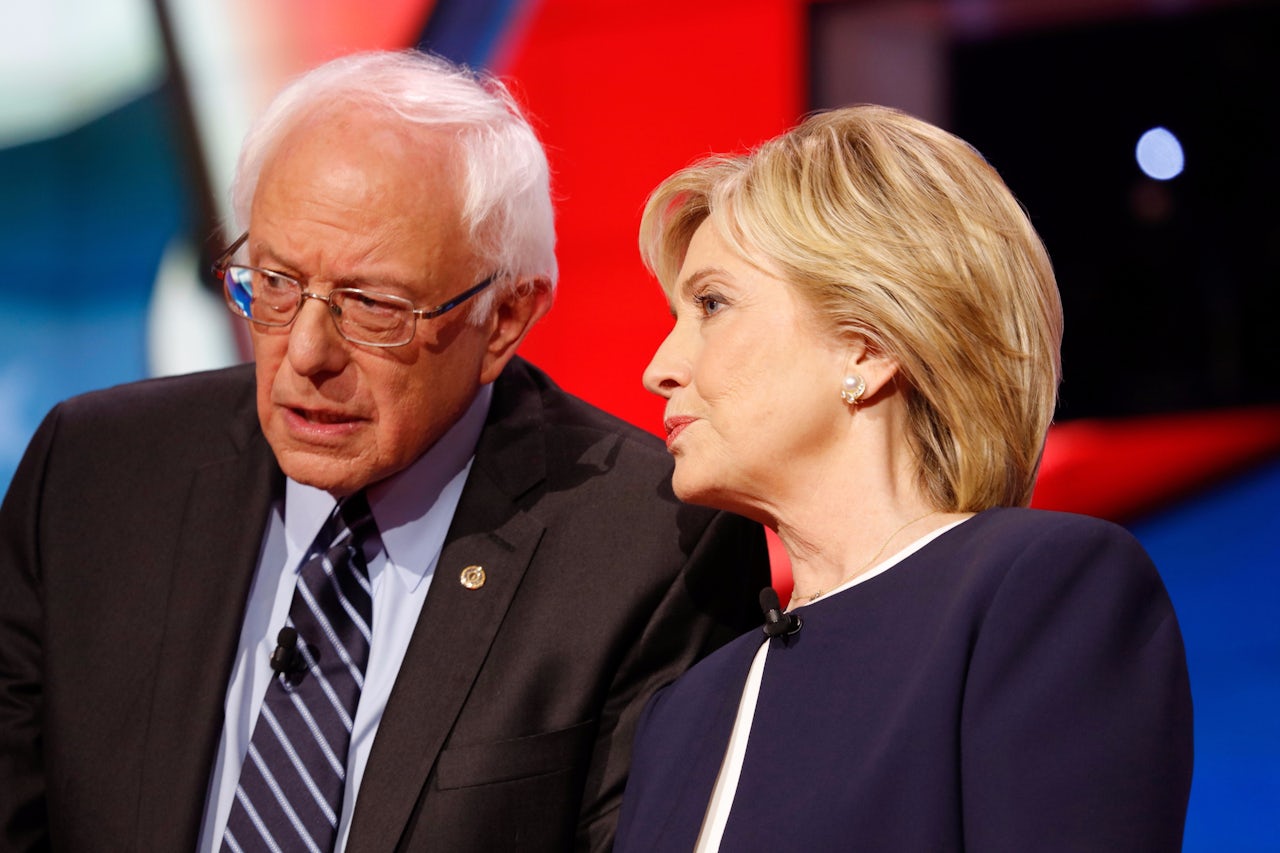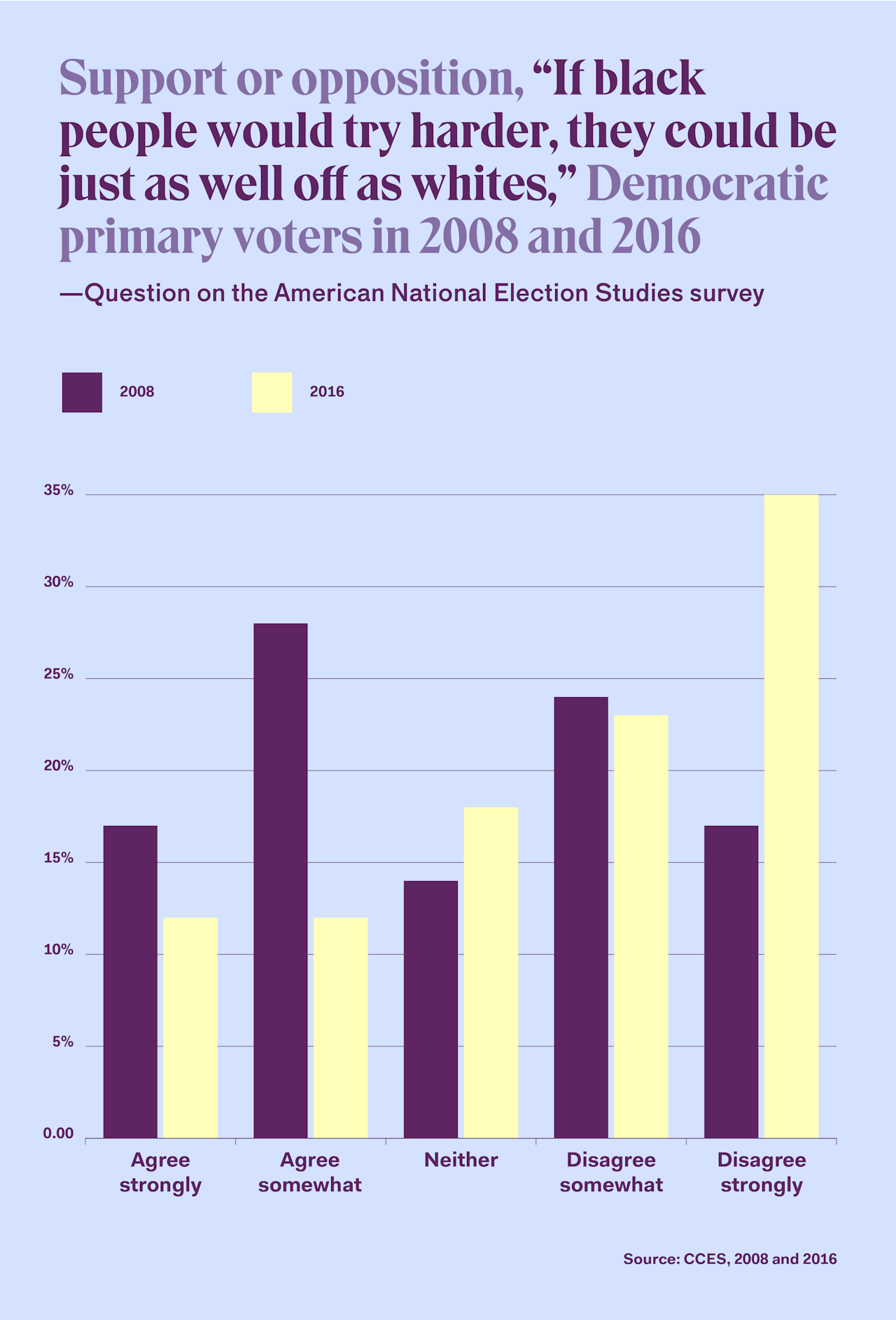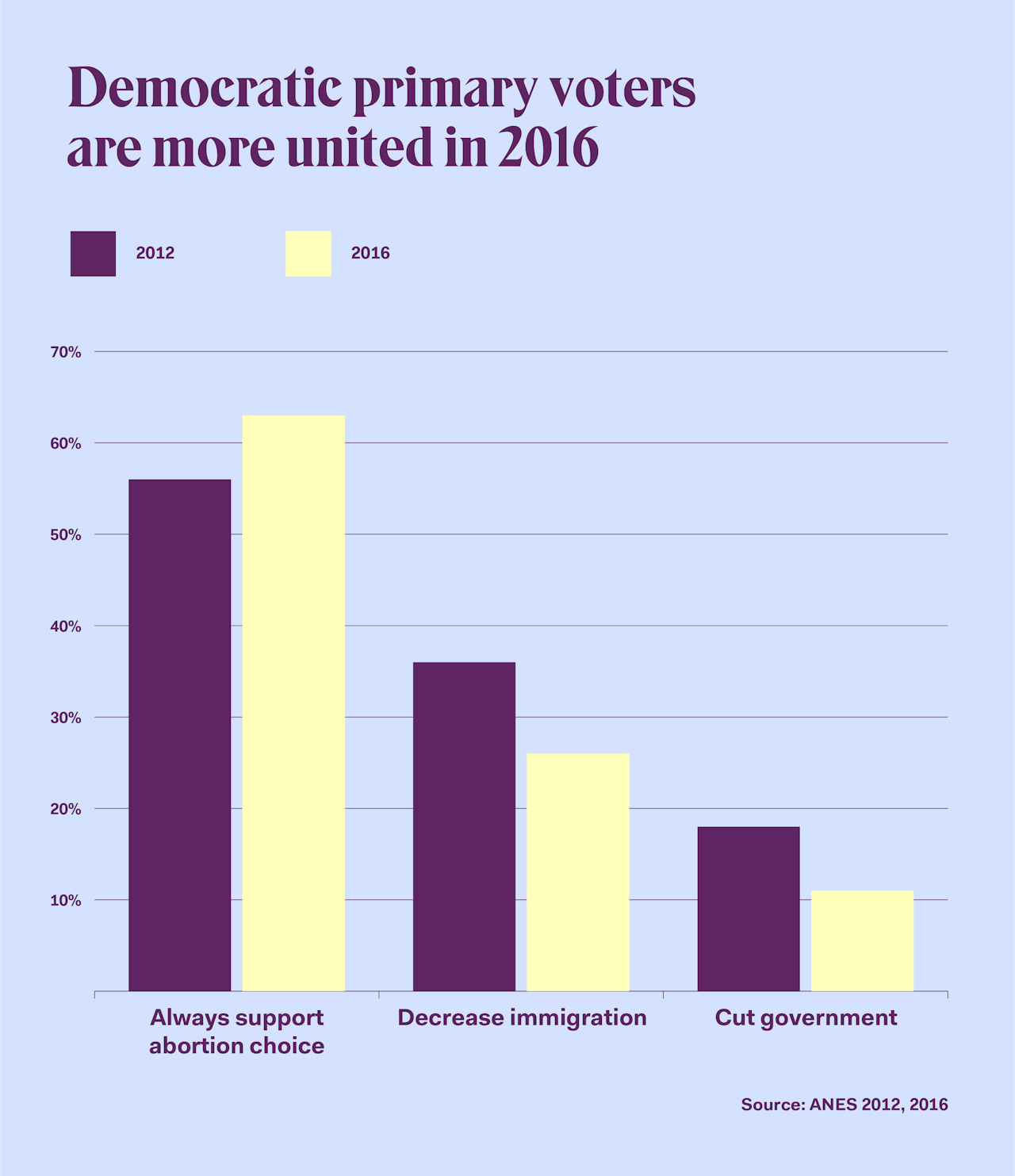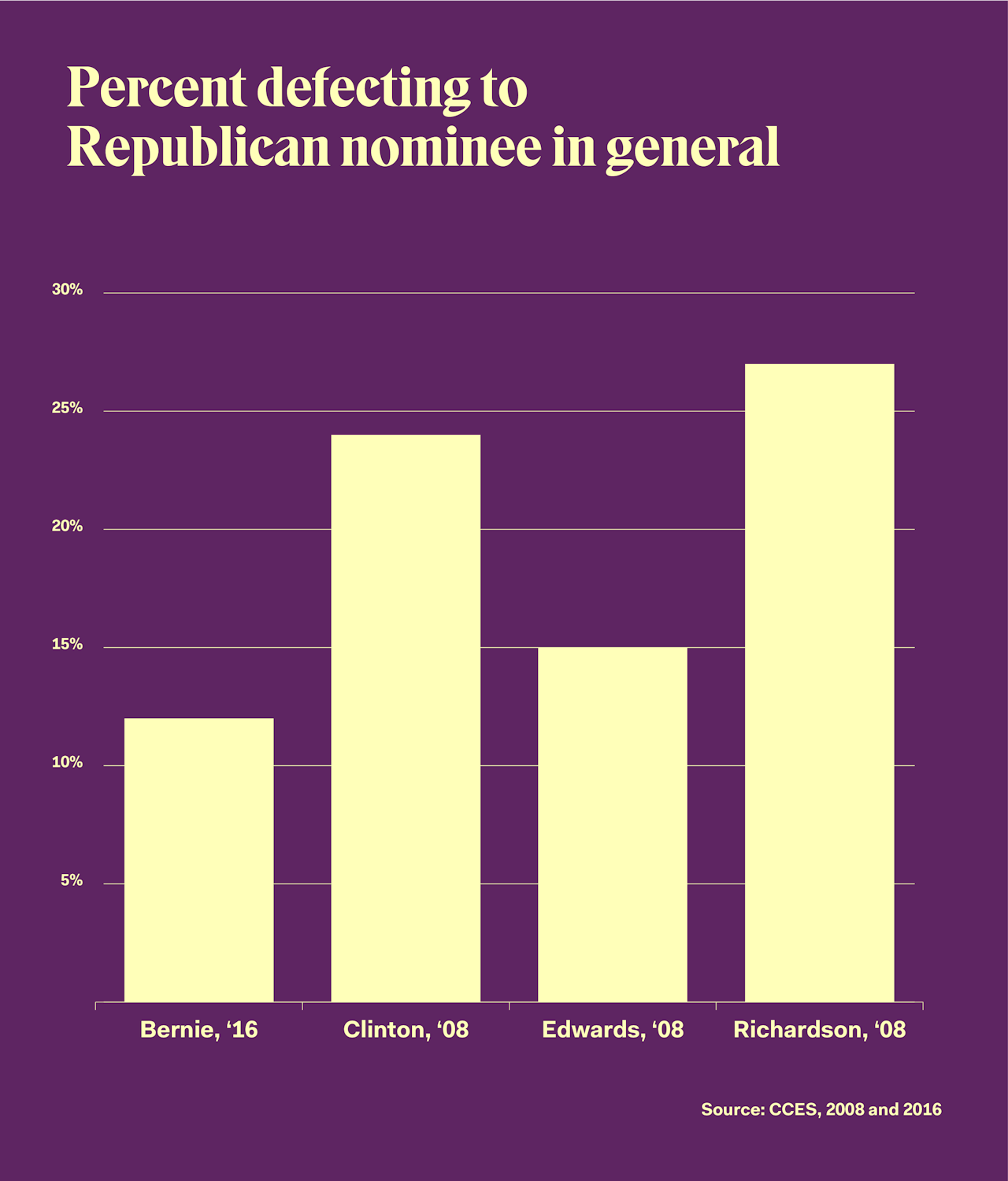Welcome to TAKE DOWN, a new column in which Sean McElwee holds pundits accountable for their hot garbage takes (and isn't afraid to be held accountable for his).
WHAT THE PUNDITS SAY
The Democratic Party is divided. It’s not hard to find headlines that either assert that as a fact or argue it. From “Hillary Clinton’s book keeps Democrats divided” (Washington Examiner) to “Democrats Are United Against Trump, Divided on Everything Else” (Wall Street Journal) to “Democrats Determined to Wage Civil War Forever” (The Daily Beast) to “Divided Democratic Party Debates Its Future as 2020 Looms” (Time) pundits are united on this point. The punditocracy normally frame this divide as reflecting the aftermath of the 2016 primary. “Democrats sweat Clinton vs. Sanders rift,” Politico tells us. The Hill’s Dick Morris was more definite, saying that the 2016 primary will divide “the Democratic Party for the next decade.” On Twitter, it’s easy to find Clinton and Sanders backers sniping at each other, and it seems like every week there’s a new group that wants to influence the future of the Party.
THE REALITY
If you look at the premise of Democratic disarray through a long lens, you'll see that the divides within the party are the smallest they’ve ever been. After the 1964 election, many party elites sought to make parties more ideologically divided (though the seeds of this “realignment” existed as early as FDR’s time). Republicans believed they could use racism to divide the Democratic coalition and win over Southern whites. Progressive Democrats, frustrated that their coalition relied on segregationists, sought to run racial liberals, who were pro-civil rights, in primaries and tie antiracism liberalism to economic liberalism.
For decades, Democrats were able to maintain some power in the South, partly due to the stickiness of partisanship, seniority on committees, aggressive gerrymandering, and running moderate candidates like Al Gore in Tennessee, Jim Hunt in North Carolina, and Bill Clinton in Arkansas, all of whom who used working-class appeals and centrist economic positions to unite (or at least satisfy) all factions of the the party. A newspaper account of Jimmy Carter’s 1970 gubernatorial bid noted that he “ran a populist-type campaign” that was aimed at winning “the supporters of George Wallace as well as those of poor blacks.” Carter opposed school busing to reduce segregation and invited George Wallace to Georgia. As the political scientist Donald S. Strong noted following Republican James Martin’s 1966 loss for Alabama governor, “No one doubted that Congressman Martin was an Alabama segregationist, but it is hard for a rich man’s segregationist to beat a poor man’s segregationist.”
Occasionally, the more racially liberal wing of the party would win a key primary with mixed general election success, but for the most part, racially conservative — or, at best, moderate — candidates have dominated the party, ranging from Mississippi arch-segregationist Jim Eastland to South Carolina’s Ernest F. Hollings, who voted against Supreme Court Justice Thurgood Marshall’s appointment to the Supreme Court, but voted for many civil rights bills and oversaw the integration of Clemson University. This led Virginia liberal Democrat Henry Howell to complain to The Washington Post, “Hell, Democrats — real Democrats — haven’t won an election [for governor] in Virginia for 100 years.”
At the presidential level, intra-party battles were far more vicious in the past than in 2016, driven largely by the civil rights movement and opposition to the Vietnam war (Osita Nwanevu’s excellent summary of presidential primaries from the ‘70s to now shows how deeply divided the party was). After the 1968 election, the McGovern Commission, which created diversity quotas for delegates and abandoned an elite selection process for democratic primaries, empowered the newer coalition — a younger, more diverse wing of the party. McGovern lost to Nixon in 1972, but his electoral coalition looked very much like the one that eventually became the base of Democratic support — women, college-educated whites, people of color, and the youth; however, this group of people did not yet make up a large enough share of the electorate to deliver him a victory.
At the presidential level, intra-party battles were far more vicious in the past.
In the ‘90s, the centrist wing lead by Bill Clinton won control of the party, but the decade was hardly a period of unity for the Democrats. Below Clinton’s two presidential wins — in which he employed moderate, anti-government appeals with coded racial rhetoric designed to appeal to white voters — the progressive faction of the party was still alive. Some of Clinton’s aides resigned after he supported a racist welfare-reform bill (Personal Responsibility and Work Opportunity Act) that brutalized the poor (a bill which deeply divided his cabinet). In 1992, the moderate Sen. Alan Dixon of Illinois lost a primary to Carol Moseley Braun partly because of his vote to put Clarence Thomas on the Supreme Court. Beverly Byron of Maryland and Charles Hayes of Illinois both lost primaries in 1992 to more progressive Democrats.
Despite talk of Democrats being united during the Bush Era, divides still existed, from positions on the Iraq War to abortion to gay marriage. The moderate wing of the party exerted significant influence, but faced challenges from a newly energized progressive wing. In 2000, conservative California Democrat Matthew Martinez was defeated in a primary by progressive Hilda Solis, who eventually served as Obama’s Secretary of Labor. In 2002, Thomas Sawyer of Ohio lost his primary to Tim Ryan due to his vote for NAFTA (and an unfavorable redistricting cycle). In 2006, Joe Lieberman lost a primary to progressive Ned Lamont, who hammered him for his support for the Iraq War (Lieberman held onto his seat by running as an Independent). Bush’s tax cuts in 2001 and 2003, unlike Trump’s, were passed with a modicum of Democratic support.
The election of Obama in 2008 sealed the end of the “centrist Democrat” era, and the 2016 primary showed this reality. Presidential candidates like Jim Webb, who wanted to pursue a path of racially moderate appeals, were doomed. The number of pro-life Democrats in the House has dwindled from more than three dozen to three in less than a decade. In 2009, 64 House Democrats voted for an amendment to exclude abortion coverage from the Affordable Care Act. By 2015, only three of those Democrats voted for a similar measure (nine Democrats flipped their position, the rest were no longer in the House). Of the 34 Democrats who voted against the ACA, three remain (and one faces a competitive primary). During this period, as research by political scientists Seth Hill and Chris Tausanovitch shows, primary voters became more consistent ideologically, bringing about fewer conservative Democrats and liberal Republicans.
This brings us to today: A Democratic party united in opposition to Trump, and in closer alignment on issues like abortion, health care, and climate change. This is not to say the party is completely united �� the core question at the heart of it is what it means to be a progressive or a liberal, rather than whether the party should be liberal or progressive.
It’s Obama’s Party Now
On most core issues the parties become more united. Take one question that is a standard measure of racial resentment: “It's really a matter of some people not trying hard enough; if blacks would only try harder they could be just as well off as whites.” As the chart below shows, Democratic primary voters have become far more opposed to that sentiment since 2008, as the party has sorted to become more racially liberal — supportive of more action to alleviate racial inequality and supportive of more immigration.
As the chart below shows, Democratic primary voters in 2016 were more likely to agree with the more progressive position than they were in 2008 on issues like abortion, immigration, and government spending. In the case of abortion, respondents were also offered the option of supporting abortion in some instances or never at all, and the share supporting abortion in all cases increased (the share saying “never” remained around eight percent).
The 2016 Democratic Primary, despite all the anger it inspired on Twitter, stands out historically for its lack of ugly rhetoric (many have quickly forgotten the ugliness of the 2008 Democratic primary). Consider 1992, when California Gov. Jerry Brown and Bill Clinton were locked in a primary contest so ugly that Brown refused to concede until the convention. The 2016 DNC was punctuated with some protests, but no outright violence (at the infamous 1968 convention in Chicago, thousands of law enforcement officials were called to brutally suppress anti-war protestors). As the chart below shows, Democratic primary voters in 2016 were less likely to defect from the party than in 2008. As I’ve argued in the past, this is consistent across longer time periods, multiple different surveys and has widespread support in the academic literature.
Looking Ahead
Despite the punditocracy’s seemingly neverending focus on Bernie vs. Hillary, pitting the two former candidates against each other is not a helpful way to understand challenges the Democrats face. In the most important primary of 2017, between Tom Perriello and Ralph Northam for governor Virginia, the core divide was between national and state Democrats, rather than those who supported Bernie or Hillary (Clinton’s camp, Obama’s camp and Sanders’s camp endorsed Perriello, while Northam had the backing of most state officials). After Perriello lost, he went across the state campaigning for Northam. Downballot, the reality on the ground was far from a party in disarray, but rather a broad swath of candidates running from a variety of backgrounds, all with support from the institutional Democratic party, from a trans woman who wanted to fix the roads, to a democratic socialist advocating for single-payer health care. In the race for governor in Georgia, Stacey Abrams has the endorsements of EMILY’S List and Nina Turner of Our Revolution in her campaign against Stacey Evans. Neither candidate cuts a Sanderesque or Clintonesque mold. To the extent that a Democratic divide emerges, it’s mostly conflict between state and local parties and powerbrokers and national progressives.
Pitting Bernie and Hillary against each other is not a helpful way to understand the challenges the Democrats face.
There are too many other similar candidates to mention here, but I’ll bring to light a few: In Texas’s 23rd district, Gina Ortiz Jones, a lesbian Filipina Air Force vet and intelligence expert is running with the support of EMILY’s List and former Texas state Sen. Wendy Davis. She’s pro-choice and has written op-eds about how white supremacy is a threat to national security. But she’s also running to the left of the establishment’s choice on economics, talking about her childhood sometimes relying on government programs and the need for single-payer health care. Jones’s candidacy shows the weakness of understanding a false binary between “identity” and “class,” as a central divide in Democratic politics.
Michigan gubernatorial candidate Abdul El-Sayed comes from a Sander-esque mold: he’s popular among young people, loves single-payer health care, and refuses to take corporate donations. He’s running as an outsider against a more established candidate. El-Sayed is a millennial Muslim who doesn’t shy away from wonkery. He transformed Detroit public-health’s bureaucracy, which had been destroyed by privatization, by implementing wonkish incremental reforms, like lead testing in schools and free glasses for kids. The opening gambit for his gubernatorial bid was a water proposal that garnered significant local attention, due to the nearby Great Lakes and the environmental racism explored in Flint. He tells working-class whites they should worry about climate change because of asthma, not because Al Gore made a documentary. El-Sayed is running on the outsider narrative of Bernie to implement the sort of over-the-horizon progressive policies Clinton ran on.
The future of the party belongs to these candidates — ones who understand that justice is about paychecks and clean water and can mobilize youth without pandering. But the core questions at the heart of the party have been answered. No credible pundit would argue that the future of the party is bloodless centrism, and the primaries across the country reflect that. The Democrats have work to do, and have scars left over from the 2016 primary. But the party is increasingly united on the values of racial justice, immigration, gender equity, non-discrimination, universal health care and antitrust policy. It is the most united American party in modern political history.



